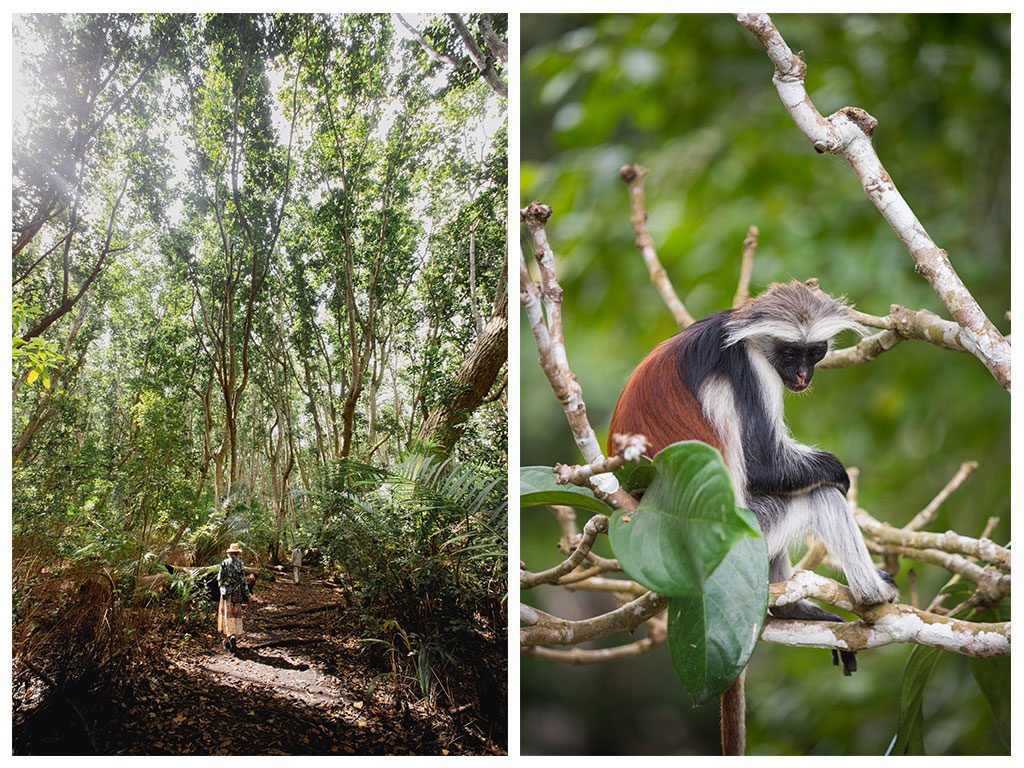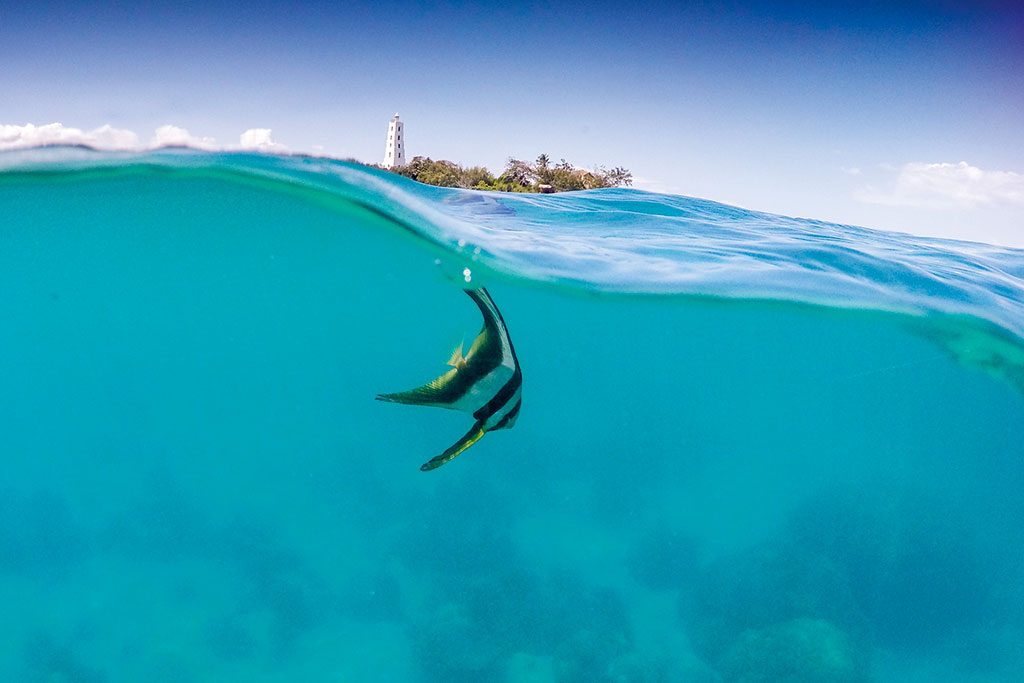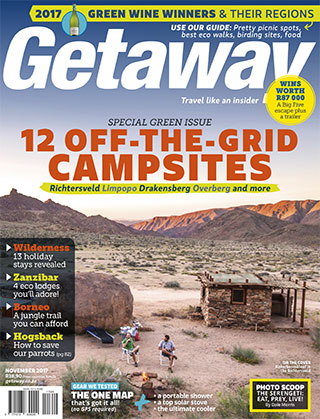
Zanzibar’s gorgeous beaches, warm water and accessibility make it one of our favourite destinations. But this tourist influx is putting stress on the island. We explore four spots that are doing tourism right.
Also read: 7 amazing day trips not to miss in Zanzibar
There are many ways to sing along to the radio. Kido has a particularly unique way of doing it. His method is to pre-empt the words, to sing them about half a second before they actually happen. We listen to a reggae cover of a Kenny Rogers country song about gambling, and Tanzanian hip-hop. Kido’s long arms are folded around the steering wheel of his taxi, and even though he’s engrossed in his singing, he’s able to fit in an appreciative whistle every time we go over a pothole.
We drive past some curious goats being shooed away from a ridiculously large mound of watermelons on a red sheet. We pass the ‘Wiz Khalifa’ library. We pass stalls piled high with lemons, limes, the kind of litchis that look like sea creatures. We pass a forest.

We don’t know it at the time, but this is Jozani Chwaka National Park, a forest that is a mishmash of human intervention. Originally a plantation set in place by a sheikh before the revolution, the tall mahogany trees have now been engulfed by Java plums, phoenix palms and invasive five-leaf vines. There’s no clear demarcation between what is indigenous and what is plantation: it’s all blurred together, egged on by the lush, incredibly fertile soil.
Tourism in the 21st century can be something of a Faustian bargain. Some countries hunger for tourist dollars to boost their local economies, but for others there’s a tipping point where they become victims of their own success. Mass tourism can fundamentally change the heart of a place and some cities are calling for measures to actively discourage it. Mayor of Barcelona, Ada Colau, has recently introduced legislation aimed at throttling the tourist numbers there, which is necessary ‘if we don’t want to become like Venice’. (In Venice, authorities implemented crowd control measures this past summer, and are considering charging an entry fee to St Mark’s Square.)
Zanzibar sits in an uneasy balance between the two. Tourism is an important industry for putting food on the table, and yet the island is under-equipped to deal with the thousands of water bottles, packaging and tonnes of waste the hospitality industry produces. Tourist numbers doubled last year; the goal is to reach 500000 visitors by 2020. On an island that has only 2461 square kilometres to work with, waste is a perennial problem. There’s also the issue that many establishments are foreign-owned, with tourist dollars being whisked into international coffers as soon as the credit cards are swiped.

Seeing as environmental issues can feel (a) depressing and (b) eternal, it’s not surprising that many travellers choose to put a kibosh on the whole nasty situation and let it float out of mind like a vrot coconut. People come to a tropical paradise for a holiday – we work very hard for those 10 days of turquoise waters, soft sand and happy selfies – and as South Africans, we have enough problems at home.
But there’s an alternative: for travellers who want to see how their money genuinely improves the island, a number of lodges are putting sustainable travel at the centre of their business. Red Monkey Lodge is one of them. Like several accommodation spots in Zanzibar, it’s been accredited by Responsible Tourism Tanzania – a Fair Trade-like company that grades businesses on a number of metrics, from salary scale to water usage. Red Monkey is tucked into a corner of Jambiani beach, where the blue water stretches out shallow and clear as a shot of gin.
This coast is where the wind hits, so windsurfers and mounds of seaweed wash up here. Women in luminous kangas the colour of saffron, turmeric and fresh coriander walk up and down the shore at low tide, scooping the seaweed into baskets balanced on their heads. Some of this seaweed is destined to become the soap used at Red Monkey and other lodges around Zanzibar.

As soon as we sit down at the lodge, we’re told by director Mark Dieler that sustainable tourism doesn’t exist. ‘You came here on a plane, no? Zero impact is not possible. What you can do is responsible tourism, minimise the impact. That’s the best you can do.’
Mark puts us in contact with the grassroots environmentalist of this area, known by his surname, Okala. He started Jamabeco, an NGO that helps with a variety of marine projects. Okala is tall, with a handsome grin and fine grey hair on his arms, and you will never see anyone speak more enthusiastically about the importance of bins. (How are you supposed to teach children not to litter, he asks, when there are no public bins?)
Another Jamabeco project uses aquaculture to provide an alternative source of income for fishermen. Okala’s brother takes us out on a dhow to see a sponge farm – it’s more a grid of ropes out in the open sea, but we get into the water for a closer look anyway. (It turns out that live sponges look exactly the way you’d imagine they do.) Still, we splash about enthusiastically in that hallucinogenic blue water and admire a school of juvenile batfish swimming past. We later see these sponges for sale at a spa for $30 each.

Driving back from the beach, I gaze out of the window as we pass boys sitting under a fig tree and makeshift stalls selling refilled bottles of cooking oil, clutches of bananas dangling from their beams, and think about how familiar it all feels. It was a trip to Zanzibar that landed me a job at Getaway. A chance meeting, an email address, one awkward interview and here I am, four years later, blinking back assignments and late nights in the office, salty and sunburnt in an East African taxi.
I had come to the same beach the last time I was here, with a lunch of redskin peanuts wrapped in chapatti. A packet of peanuts was 50 shillings, a ludicrously tiny amount, and sitting on the beach was free. I would never have been able to afford the places I’m visiting now. I thought of myself as a neo-peasant, not quite realising that the ability to travel on a shoestring budget was a privilege I had yet to account for. I was the sort of person who had lots of opinions about the difference between ‘travellers’ and ‘tourists’. I’m glad to know, now, that things are a bit more complicated than that
– that investing in a place, as well as experiences, can bring you closer to a destination. I order a gin and tonic, and pay for it.

Three days later. It’s 15:34 on a Thursday afternoon and Omari Nyange is laughing as he tells us the story of how he nearly died. We’re standing on a sharp cliff of crumbling coral on Chumbe Island. The boat taking him back to the mainland will leave in 26 minutes and we should all probably be heading back, but neither photographer Teagan Cunniffe nor I are able to tear ourselves away.
Omari says he was monitoring the marine life around Chumbe Island – counting each urchin, each parrot fish in one of 15 square-metre transacts, something he’s done every day for the last two decades – when he was swept several kilometres out to sea in an unforgiving rush of water. He is chuckling, for some reason, as he describes giving up hope. He washed up on shore four hours later, and when he got back to Chumbe Island the next day he was informed of a warning about staying out of the water due to an extreme event in the Indian Ocean out towards South East Asia. This was on 26 December 2004.

This isn’t the only dangerous experience Omari has had as a custodian of Chumbe Island. When it was declared a marine park in 1991 – the first and still the only private one in Africa – he and a colleague were camping wild on the island they’d recently been employed to protect. From what, or who, you might ask? From the generations of fishermen who had, until recently, been able to fish here. Fishermen began arriving in their dozens under the cover of night, shaking their tents and asking the two men who, exactly, were they to tell them they couldn’t sh there anymore? Just two guardians, and the forest, and a gang of frustrated, hungry people. It was a dangerous time.
Not many of the rangers could take it, and indeed none of them stayed – Omari is the only one of the old guard left. His years of service have paid off, though. Chumbe Island is a marine paradise – 90 per cent of East Africa’s coral diversity is represented on this reef, with 440 recorded fish species, and snorkelling here is the best I’ve seen anywhere in the world. We freedive to get a closer look at the coral and hear the songs of humpback whales juddering through the water from out at sea.

A few days later we’re back to the spot where my last journey to Zanzibar began and ended. Forodhani Gardens is a main attraction in Stone Town, the shiny grin of its boardwalk curving up from the harbour around the point studded with beautiful trees that overlook the houseboats bobbing out at sea. Boys leap off the pier, one- pping each other with daring spins and leaps. There’s an open-air market here every night, and it’s a good place to get dinner for a song.

The last time I stood here, it was the beginning of something monumental – some secret door in me being cracked open. Maybe that’s simply what travel does, why we love it so much. But life moves on, with or without us. At Forodhani, the fires are being lit, knives are clacking over mountains of onions, smoke is tingeing the air. It’s just another night.
Plan your trip to Zanzibar
Getting there
We flew with Mango from Johannesburg direct to Zanzibar (no long layover in Dar es Salaam). Flights operate every Tuesday and Saturday and take about three-and-half hours. Keep an eye on Mango’s website for specials and deals. From R7200 return. flymango.com
Need to know
South Africans do not need a visa for Zanzibar. Many places recommend you take malaria medication; we didn’t, and relied on repellent and the ubiquity of mosquito nets. Be careful when wading through sea grass near to shore, as it is often home to poisonous sea urchins. Note that there’s no need to hire a guide for Jozani Forest – you’ll be assigned an accredited guide when you pay your entrance fee.
When to go
Zanzibar has two rainy seasons, visit between July and October (we travelled in July) or December and March. The latter is the height of summer though, which can be very warm indeed.
What it costs
Taxis and restaurant services are surprisingly expensive and can add up very quickly. Avoiding the obvious pitfalls, this trip costs around R16000 per person, including flights and four excursions.
What to do

Go on a bike tour to a Spice Farm. Love Zanzibar runs a variety of bicycle based tours around the island. We cycled the 15 kilometres from Stone Town to Kizimbani and back. After weaving through downtown traffic, we entered an oasis of tall palms and delicious fruit. From R550 per person, including bicycle hire and lunch. lovezanzibar.com
Visit Kwale Island with Blue Safari. Leaving by dhow from Fumba village, you’ll go to two locations, then have a seafood braai (veg option available) on a private beach on the island, home to a magnificent 300-year old baobab. R840 per person. safariblue.net
Snorkel at Chumbe Island. Staying here is pricey, but the day trip offers great value with a guided walk around the island, snorkelling, a delicious lunch and the use of an eco-bungalow for the day. From R1190 per person – bookings can only be taken a day or two ahead. chumbeisland.com
Do a Stone Town tour. There’s too much to see in one day, so ask your guide to tailor a route to your interests. We went with Hammad Ali from Eco & Culture Tours, whose history knowledge was impressive – ask about the slave chambers below the Anglican Church. From R236 per person. ecoculture-zanzibar.org
Where to stay

Mustapha’s Place is a hippie oasis of bougainvillea and frangipani in Bwejuu All the rooms are different and made from local materials. From R397 per person sharing B&B. mustaphasplace.com
Hodi Hodi comprises three boutique beach villas under ridiculously tall palms, with original Zanzibari doors and architecture. Host Julia Bishop is a riot. Don’t miss the three-course dinner, from R333 per person. Standard room from R1290 per person. hodihodizanzibar.com
Red Monkey Lodge is a small beach lodge that combines easy-going backpacker energy with 14 lovely rooms. The Monday jam sessions are Jambiani’s biggest party – if you’re looking for peace and quiet, stay elsewhere that night. From R695 per person. redmonkeylodge.com
Chumbe Island offers Robinson Crusoe-style living, with beautifully designed eco-bungalows equipped with a rainwater filtration systems and compost toilets. Profits from these seven bungalows fund ll of its projects (including 40 educational trips a year for school kids). From R3715 per person sharing, including meals, boat transfers and all activities. chumbeisland.com
This story first appeared in the November 2017 issue of Getaway magazine.
Our special green issue features the best off-the-grid campsites, fantastic holiday stays in Wilderness, an affordable jungle trail in Borneo, incredible eco-lodges in Zanzibar and our Green Wine Guide is finally out with winners!

This article, Greening the big blue: eco-friendly travel in Zanzibar, was originally posted on the Getaway Blog by Kati Auld.